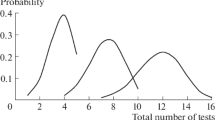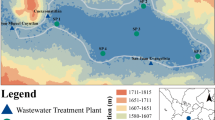Abstract
Which are applicable in all Member States. Those directives specify a set of physical and chemical characteristics, which depend on the use the water is intended for, the parameters to be regularly controlled in a network of sampling points, and the limiting values of those parameters for each quality level. Hence, an administrative quality classification for each sampling point is obtained. This article proposes a stochastic quality index that takes into account the uncertainty surrounding the quality classification still remaining after the data have been observed. This stochastic index is built with the probability classification vector of each parameter. In order to obtain those vectors, a mixed-lognormal model is introduced and its statistical analysis developed. The methodology proposed here is then applied to the data observed in the La Presa station, one of the sampling points of the Spanish surface water quality network. Located on the river Turia, near the city of Valencia, its aim is to control the quality of water intended for the abstraction of drinking water. Its stochastic quality classification is obtained and compared with the legally applicable administrative one.
Similar content being viewed by others
References
Beamonte, E., Bermúdez, J. D., Casino, A., and Veres, E. (2004a), “La Calidad del Agua en Ciertas Estaciones de Control del Canal Júcar-Turia (período 1994–2001),” Revista Española de Estudios Agrosociales y Pesqueros, 201, 105–126.
—, and — (2004b), “Un Indicador Global para la Calidad del Agua. Aplicación a las Aguas Superficiales de la Comunidad Valenciana,” Estadística Española, 156, 357–384.
Berzas, J.J., García, L.F., Rodríguez, R. C., and Martín-Álvarez, P. J. (2000), “Evolution of the Water Quality of a Managed Natural Wetland: Tablas de Daimiel National Park,” Water Research, 34, 3161–3170.
Bordalo, A. A., Nilsumranchit, W., and Chalermwat, K. (2001), “Water Quality and Uses of the Bangpakong River (Eastern Thailand),” Water Research, 15, 3635–3642.
Box, G. E. P., and Tiao, G. C. (1973), Bayesian Inference in Statistical Analysis, Reading: Addison-Wesley.
Chang, N., Chen, H.W., and Ning, S. K. (2001), “Identification of River Water Quality Using the Fuzzy Synthetic Evaluation Approach,” Journal of Environmental Management, 63, 293–305.
Chapman, D. (ed.) (1992), Water Quality Assessment: A Guide to the Use of Biota, Sediments and Water in Environmental Monitoring, London: Chapman & Hall.
DeGroot, M. H. (1970), Optimal Statistical Decisions, New York: McGraw-Hill.
Fore, S. A., Guttman, S. I., Bailer, A. J., Altfater, D. J., and Counts, B. V. (1995a), “Exploratory Analysis of Population Genetic Assessment as a Water Quality Indicator I,” Ecotoxicology and Environmental Safety, 30, 24–35.
—, and — (1995b), “Exploratory Analysis of Population Genetic Assessment as a Water Quality Indicator II,” Ecotoxicology and Environmental Safety, 30, 36–46.
Grapentine, L., Marvin, C., and Painter, S. (2002), “Initial Development and Evaluation of a Sediment Quality Index for the Great Lakes Region,” Human and Ecological Risk Assessment, 8, 1549–1567.
Hebért, S. (1997), Développement d’un Indice de la Qualité Bactériologique et Physico-chimique de l’eau pour les rivières du Québec, Québec, Ministère de l’Environnement et de la Faune, Direction des écosystèmes aquatiques, Envirodoq no EN/970102, 20 p.
Hueting, R. (1991), “Correcting National Income for Environmental Losses: A Practical Solution for a Theoretical Dilemma,” in Ecological Economics. The Science and Management of Sustainability, ed. R. Constanza, New York: Columbia University Press, pp. 194–213.
Jarvie, H. P., Lycett, E., Neal, C., and Love, A. (2002), “Patterns in Nutrient Concentrations and Biological Quality Indices Across the Upper Thames River Basin, UK,” The Science of the Total Environment, 282–283, 263–294.
Kondratyev, S., Gronskaya, T., Ignatieva, N., Blinova, I., Telesh, I., and Yefremova, L. (2002), “Assessment of Present State of Water Resources of Lake Ladoga and its Drainage Basin Using Sustainable Development Indicators,” Ecological Indicators, 2, 79–92.
Melloul, A. J., and Collin, M. (1998), “A Proposed Index for Aquifer Water-Quality Assessment: The Case of Israel’s Sharon Region,” Journal of Environmental Management, 54, 131–142.
Mogheir, Y., and Singh, V. P. (2002), “Application of Information Theory to Groundwater Quality Monitoring Networks,” Water Resources Management, 16, 37–49.
Pesce, S. F., and Wunderlin, D. A. (2000), “Use of Water Quality Indices to Verify the Impact of Córdoba City (Argentina) on Suquía River,” Water Research, 34, 2915–2926.
Poch, M. (1999), Las Calidades del Agua, Barcelona: Rubes Editorial S.L.
Popp, J., Hoag, D., and Hyatt, D. E. (2001), “Sustainability Indices with Multiple Objectives,” Ecological Indicators, 1, 37–47.
Provencher, M., and Lamontagne, M. P. (1977), Méthode de determination d’un indice d’appréciation de la qualité des eaux selon différentes utilizations, Québec, Ministère des Richesses Naturelles, Service de la qualité des eaux.
Schultz, M. T. (2001), “A Critique of EPA’s Index of Watershed Indicators,” Journal of Environmental Management, 62, 429–442.
Villalba, M., Barragán, F. J., Ternero, M., and Jiménez, J. C. (1995), “Hydrochemical Study of an Aquifer System in an Agricultural Area in South West Spain,” Water Research, 29, 1361–1372.
Author information
Authors and Affiliations
Corresponding author
Rights and permissions
About this article
Cite this article
Beamonte, E., Bermúdez, J.D., Casino, A. et al. A global stochastic index for water quality: The case of the river Turia in Spain. JABES 10, 424 (2005). https://doi.org/10.1198/108571105X80987
Received:
Revised:
DOI: https://doi.org/10.1198/108571105X80987




